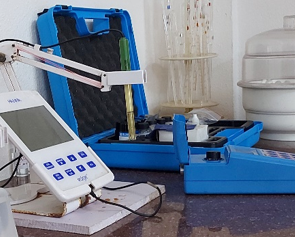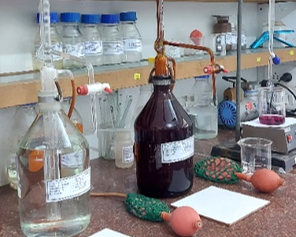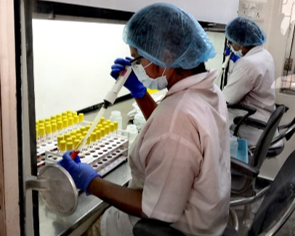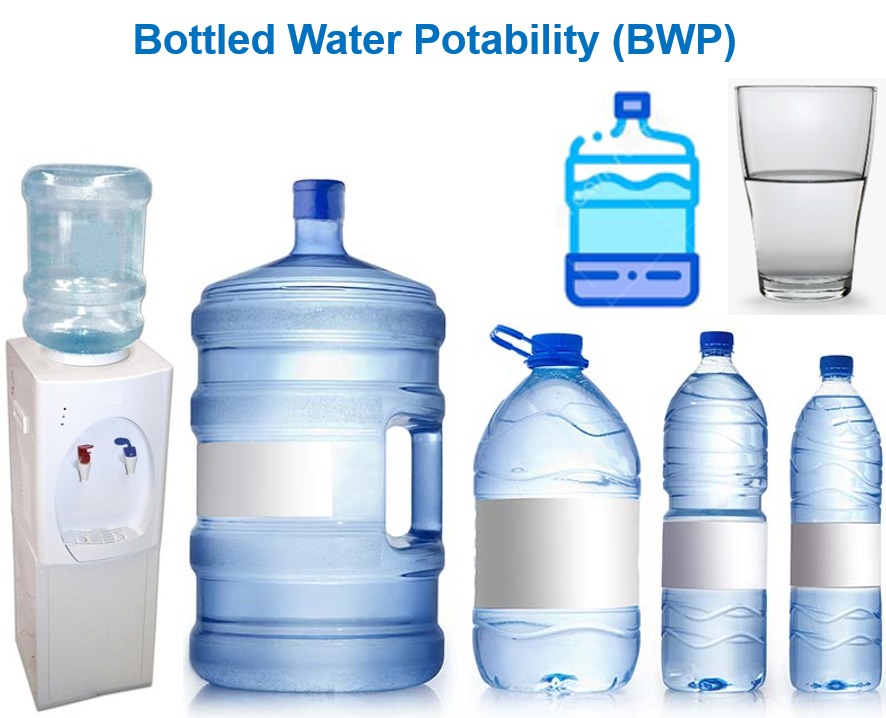Bottled Water Potability (BWP) Tests
Scope:

Physical & Sensory Parameters:
Colour (Appearance & True Colour Units), Odour, pH, Turbidity; & Electrical Conductivity (EC).

Chemical Parameters:
Total hardness of water (THW), Calcium (Ca) & Magnesium (Mg); Nitrate (NO3); Fluoride, Boron, Chloride, Sulfate, Iron (Fe) & Manganese (Mn), & Sodium (Na).

Bacteriological Parameters:
Detction of Total coliforms & E. coli in 100 ml; by
Membrane Filtration & Chromogenic agar plating (MFC),
Or Enzyme Substrate Autoanalysis (ESA).
Total parameters: 5 + 11 + 2 = 18
Rationale:
Bottled water means safe drinking water that is sealed in bottles or other containers and is synonymous with packaged drinking water other than packaged natural mineral water. In addition to health benefits consumers value the convenience of bottled water. Commercially bottled water is emerging as the primary source of drinking water while travelling, hotels and restaurants and at the work place. About 13% households in Hyderabad primarily use bottled water for drinking. Groundwater is the primary source of raw water for most bottled water plants. Bottled water is being produced by a variety of plants ranging from micro and small to very large enterprises. New bottled water plants often start as micro enterprises hoping to gradually expand in size. Wide variation in age and size of bottled water plants mean concomitant variation in quality control measures.

Almost all bottled water plants use reverse osmosis (RO). One of the side effects of RO is excessive removal of minerals. Low mineral content water tastes poorly, does not quench thirst so well. Mineral free, low pH water tends to leach impurities into drinking water, from metallic containers (WHO 2022; Kozisek, 2005). Some researchers have recommended that, the minimum level of calcium in drinking water should be 20 mg/L and the optimum should be 50 (40-80) mg/L. Similarly, the minimum level of magnesium in drinking water should be 10 mg/L and the optimum level should be about 20-30 mg/L (Kozisek, 2005, Pages 156-57). An expert committee constituted by the National Green Tribunal, recommended that bottled water for drinking should have a minimum TDS concentration to 150 mg/L (NGT, 2019). As of 2022, the mineral content in most of the bottled waters available in Hyderabad is low. When consumers test bottled water ask their suppliers about desirable mineral content, the aesthetics and stability of bottled water is bound to improve.
Once selected, consumers often continue with the same bottled water supplier. Testing for quality of bottled water is critical for initial selection of suppliers. Thereafter, quality should be checked periodically, to reassure that delivered bottled water continues to be safe and suitable for drinking.
There are 3 Indian standards for drinking water, namely; IS10500, IS13428, and IS14543. IS10500, originally published in 1983, revised in 2012, amended several times and reaffirmed in 2023, has been developed for safe water supply to general public by municipal and other water utilities. IS10500 is often used as a reference for several other purposes. IS13428, originally published in 1992 and revised for third time in 2024, applies to natural mineral waters packaged and sold for drinking. IS14543, first published in 1998 and revised for third time in 2024, applies to water from various sources, treated and packaged for drinking. The key difference between the two packaged drinking water standards appears to be that, IS13428 applies to pristine raw water minimally treated for safe drinking and IS14543 applies to a wider range of source water adequately treated to ensure safe drinking.
| Sl | Parameter | IS 14543 | IS 13428 | IS10500: Acceptable | IS10500: Permissible |
|---|---|---|---|---|---|
| True colour units, PCU | ≤ 2 | ≤ 2 | ≤ 5 | ≤ 15 | |
| Odour | Agreable | Agreable | Agreable | Agreable | |
| pH | 6.0 to 8.5 | 6.5 to 8.5 | 6.5 to 8.5 | 6.5 to 8.5 | |
| Turbidity, NTU | ≤ 2 | ≤ 2 | ≤ 1 | ≤ 5 | |
| Total dissolved solids, mg/L | ≤ 500 | 150 to 700 | ≤ 500 | ≤ 2000 | |
| Alkalinity as CaCO3, mg/L | ≤ 200 | 75 to 400 | ≤ 200 | ≤ 600 | |
| Hardness as CaCO3, mg/L | ≤ 200 | ≤ 600 | |||
| Calcium as Ca, mg/L | ≤ 75 | ≤ 100 | ≤ 75 | ≤ 200 | |
| Magnesium as Mg, mg/L | ≤ 30 | ≤ 50 | ≤ 30 | ≤ 100 | |
| Ammoniacal-N as NH3-N, mg/L | ≤ 0.5 | ≤ 0.5 | |||
| Nitrite-Nitrogen as NO2-N, mg/L | ≤ 0.02 | ≤ 0.02 | |||
| Nitrate as NO3, mg/L | ≤ 45 | ≤ 50 | ≤ 45 | ≤ 45 | |
| Fluoride as F, mg/L | ≤ 1.0 | ≤ 1.0 | ≤ 1.0 | ≤ 1.5 | |
| Boron/Borates as B, mg/L | ≤ 5.0 | ≤ 5.0 | ≤ 0.5 | ≤ 2.4 | |
| Chloride as Cl, mg/L | ≤ 200 | ≤ 200 | ≤ 250 | ≤ 1000 | |
| Sulphate as SO4, mg/L | ≤ 200 | ≤ 200 | ≤ 200 | ≤ 400 | |
| Sodium as Na, mg/L | ≤ 200 | ≤ 150 | |||
| Iron, mg/L (See Note-1) | ≤ 0.1 | ≤ 0.1 | ≤ 1.0a | ≤ 1.0a | |
| Manganese, mg/L | ≤ 0.1 | ≤ 2.0 | ≤ 0.1a | ≤ 0.3a | |
| Free residual chlorine, mg/L | ≤ 0.2 | ≥ 0.2b,c | ≥ 1.0b | ||
| Total coliforms | Absent in 250ml | Absent | Indicator of cleaniness | ||
| E. coli | Absent in 250ml | Absent | Absent in 100ml | ||
| Notes: a. Sum of Iron as Fe &mapl; Manganese as Mn should not exceed 0.3 mg/L. b. Free residual chlorine is tested at consumer end & applicable only when water is chlorinated. When protection against viral infection is required, the minimum should be 0.5mg/L. |
|||||
In BWP, we have packaged a good number of physical, general chemical and bacteriological parameters to check for aesthetic quality, chemical components and to rule-out microbial contamination.
The Indian standard for packaged drinking water (IS14543, 2024) lists 53 parameters including, 10 bacteriological, 6 physical & sensory, 25 general chemical parameters, 10 toxic and 2 radioactive substances. Inclusion in the standard specification does not mean that all 53 quality parameters have to be tested all the time. Choice of parameters for monitoring and verification of quality is to be based on reliability of the source, variability of parameter values, prevalence of attributable risk, consumer concerns and clues leading to suspicious contamination. The bottled water potability tests covers all physical & sensory parameters, except for taste, which would be known to the consumer. Two essential bacteriological parameters are included. The World Health Organization (WHO) recommends coliform bacteria as useful indicators for assurance of drinking water quality. Presence of E. coli is an indicator of contamination with human sewage. Total coliforms in the absence of E. coli would be an indicator for cleanliness and integrity of distribution systems (WHO, 2011). And 11 out of 25 general chemical parameters listed in IS14543 of 2004 are included. BWP does not include any of the toxic or radioactive substances listed in IS14543. Where contamination with pesticides and any other toxic substances is suspected, additional tests should be considered.
Sample - Collection, Storage & Transportation:
Indian Standard (IS) 17614 (Part 1) of 2021 provides guidance on the design of sampling programs and sampling techniques. Follow methods of sampling specified in IS 3025 part 1: 1987 for chemical tests and in IS 1622: 1981 for bacteriological tests. Sample should be representative of the water to be tested and should be collected with utmost care to ensure that no contamination occurs at the time of collection or prior to examination by the laboratory.
Pouring of bottled water into a separate sample collection bottle may not be required. For acceptance testing, selected sample of packaged water bottles should be sent to the laboratory unopened ((IS14543 Annex E.1). In case of large bottles such as 20 litre cans, meant to be used with help of dispensers, pour from a freshly opened can into a sterile sample collection bottle. If you are interested in testing potability of a partially used packaged water bottle, no need to pour it into a sterile bottle. Instead, place the partly used water bottle into a dark-coloured bag, along with some ice pack and deliver to the Laboratory for analysis.
Information About Source, Context, Intended Use & Concerns:
Provide as much detail as you can about the supplier, batch number, bottling date, date of opening of bottle, etc. Mention about intended use of the water, the reason why you are ordering the test, as well as doubts and concerns, if any. These information help in interpretation of test results. Occasionally, the IHS Laboratory may contact you for clarifications and additional information about the source and its environment, to help interpretation of test results.
Test Method & Duration:
Physical and chemical characteristics of water sample are tested according appropriate parts of the IS3025 and/or American Public Health Association (APHA). For bacteriological analysis methods specified in APHA Standard Methods or IS15185 of 2016 are used. Report will be available in 3 to 5 days, depending on duration of bacteriological analysis and gathering of additional information, if any is required.



To pick up sample collection bottle and/or schedule collection of samples: Email: ihslab@ihs.org.in with your address and contact telephone; OR WhatsApp: +919848011251; Or Call: 23211013/4.
References:
- IS10500, 2012. Table-6 in Indian Standard Drinking Water Specification. 2nd Revision. New Delhi: Bureau of Indian Standard (BIS); 2012 May, RA2023Amd4.
- IS13428. 2024. Packaged Natural Mineral Water - Specification (3rd Revision). New Delhi: Bureau of Indian Standards.
- IS14543. 2024. Packaged Drinking Water (Other than Packaged Natural Mineral Water) - Specification (3rd Revision). New Delhi: Bureau of Indian Standards.
- IS17614 (art 1), 2021. Water Quality – Sampling. Part 1 Guidance on the Design of Sampling Programs and Sampling Techniques. New Delhi: Bureau of Indian Standards.
- IS1622: 1981, RA2019. Methods of Sampling and Microbiological Examination of Water. 1st Revision. New Delhi: Bureau of Indian Standard (BIS).
- Kozisek Frantisek. 2005. Health Risks from Drinking Demineralised Water. Ch-12 in: WHO. Nutrients in Drinking Water. Geneva: World Health Organization (WHO), 2005: 148-63. https://apps.who.int/iris/handle/10665/43403
- NGT. 2019. Whether RO plants need to be deployed at all locations irrespective of water quality of raw water. Judgement. New Delhi: National Green Tribunal, Principal Bench; Original Application No. 134/2015. https://greentribunal.gov.in/sites/default/files/all_documents/ReportApplicationNo134-2015._compressed.pdf
- WHO. 2003. Total dissolved solids in Drinking-water. Background document for development of WHO Guidelines for Drinking-water Quality. Geneva: World Health Organization (WHO); 2003. https://www.who.int/teams/environment-climate-change-and-health/water-sanitation-and-health/chemical-hazards-in-drinking-water/total-dissolved-solids
- WHO. 2022. Guidelines for drinking-water quality. Fourth Edition, 1st & 2nd Addenda. Geneva: 2022. https://www.who.int/publications/i/item/9789240045064
